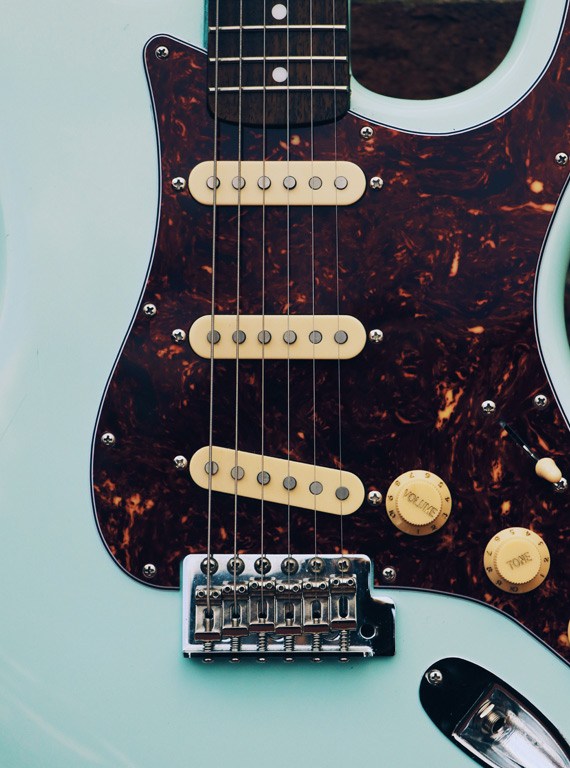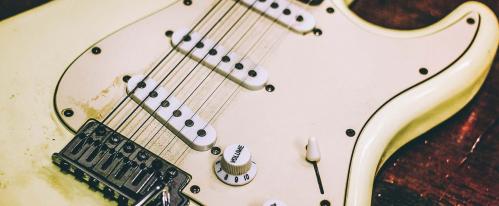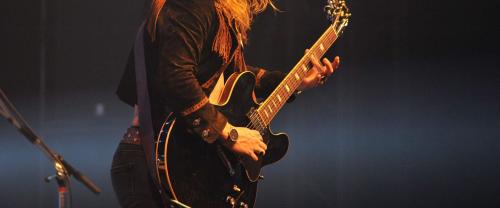HERE'S 5 ESSENTIAL ROCK AND BLUES LICKS IDEAL FOR BEGINNER GUITARISTS COURTESY OF THE GOOD PEOPLE OVER AT MGR MUSIC TUITION!
We're back with another set of essential rock and blues licks and guitar techniques as part of our PMT College series. This time, we've teamed up with Leigh at MGR Music Tuition to discuss some really cool Blues and Rock phrases that will help breathe new life into your solos and riffs. So, you’re ready to get stuck into playing rock lead guitar, are you? In this lesson, we’re going to look at 5 awesome licks that you can start playing today and we’ve also got a backing track for you to play along with to test these licks out and create your own!
Watch the Rock & Blues Licks Video:
How to use the backing track:

We've included a handy Blues backing track, but it's worth finding out how to use it first!
The backing track is made up of a riff in the key of E Minor. The riff uses power chords and single notes along with a few rhythmic rests to create a groove (see above). The first bar starts on the “a” of the four-beat count in. This means you’ll be playing slightly ahead of the beat:
“1, 2, 3, 4 e & a”
This is then true of each bar; the E power chord is hit on this same beat. The first and third bar of this riff are the same each time after the initial chord is hit, there is a series of palm-muted open E strings. A good way to imagine this rhythm is to visualise it as 16th notes but highlight which beats you actually play:
“1 e & a 2 e & a”
The back half of the bar is straight 16th notes on the “3 e & a 4 e & a”.
Bars 2 and 4 start with the same open string rhythm on the first 2 beats with a power chord on the third and fourth beats. The second bar we use a D and C power chord rooted on the A string and the fourth bar is an A and a G power chord rooted on the low E.
Rock & Blues Backing Track:
Minor Pentatonic Scale
In our last lesson, 5 Essential Electric Guitar Techniques Guitarists Must Know we talked about the Minor Pentatonic Scale in 2 different shapes. The licks in this lesson will be using the same scale shapes but this time we will be playing them in the key of E Minor, meaning we will be starting the first shape from the 12th fret of the Low E string. This time we will also be adding a third shape to this scale grouping.
Shape 1:

Shape 2:

Shape 3:

Blues LICK 1

The first lick starts with a bar of unison bends played as quarter notes. A unison bend is when you play notes on 2 adjacent strings, in this case the B and E strings. The 15th fret of the B string is played at the same time as the 12th fret on the E string, then the B string note is bent upwards to match the note of the E string.
The second bar is a descending pentatonic lick that runs in straight 16th notes except for the final note which is an 8th note.
The only exception to the pentatonic rule here is the 15th fret on the G, this note sits outside of the standard pentatonic scale and is known as the blues note. Any time we have two notes on the same string together we can play them as a pull off, when it comes to the G where there are 3 notes together, the 15th is slid down to the 14th before pulling off to the 12.
Blues LICK 2

Lick number two in our Essential Rock and Blues Licks starts with a full step bend on the high E string which lasts for two beats. You want to add a bit of overdrive to your amp to make this sustain. The difficult part of this lick is the fast flurries in the second bar. This phrase starts on the “& a” of the fourth beat where you play the 12th fret on the E string twice before launching into a pull off phrase.
The phrase is the same for the first three beats, the only thing that changes is the first note. The first repeat is the 17th fret to the 12th on the E as a pull off, the second beat is the 15th and the third beat goes back to the 17th.
The final beat is a three note pull off on the E string from the 15th to the 14th to the 12th fret. These three notes pull offs can be tricky as you’ll be doing two separate pull offs with one motion.
Blues LICK 3

This lick looks intimidating on paper as it is two bars of straight 16th notes but it is not as bad as it seems. This is one of those licks that looks and sounds more difficult than it is which in turn makes the listener think you’re doing something very technical.
When picking this lick you will want to stick to strict alternate picking all the way through. The first bar has one fretted note per beat followed by three open notes.
Your fretted notes will hit on the beat of each bar and the opens on the “e & a”.
The second bar doubles the pace of the fretted notes, so they now hit on the beat and on each “&” which the opens fall between. The notes from this lick cross the three shapes of the minor pentatonic scale except for the 14th fret which comes from another scale called the Natural Minor scale, for the purpose of this lesson we’ll just use that note as an outside scale note.
Blues LICK 4

This Blues lick is quite simple to play but its challenge lies in the phrasing of each small part. Like the E power chord in the backing riff, this lick starts on the “a” of the fourth beat of the preceding bar. The form of the first three bars is the same with a slide to the 12th fret of the B right before the first beat. The is a bend at the end of the phrase from the 14th fret on the E up to the 15th.
The second time the phrase repeats, this bend shifts to the 15th fret as a full tone before returning on the third repeat to a semi tone bend on the 14th fret again.
The final phrase starts with the same slide, but this time has a quick legato passage which involves doing a hammer-on from the 14th to the 15th fret before pulling off again back through the 14th to the 12th fret. The lick ends with a picked noted on the 14th fret and a slide up to the 17th fret from the 12th which is then sustained.
Blues LICK 5

This final lick is an ascending lick with a fast flurry across three strings at the end. The start of the lick is ascending 16th notes that run up the pentatonic scale. Play each note twice as you climb the A, D and G strings before ending the first bar with a quick flurry made up of a hammer on and pull off on the G string across the first half of the fourth beat as a triplet and two 16th notes to end the bar.
The second bar is two beats of straight 16th notes played as a full step bend on the 14th fret of the G, the 12th fret on the E and a pull off from the 15 to the 12 on the B.
This is repeated on the second beat. The final two beats are unison bends similar to the first lick.
About the Author Leigh Fuge is a professional guitar player and tutor from Swansea in South Wales and a guitar writer having written and produced content for Guitar Magazine and many other high profile guitar publications and websites. If you enjoyed this Essential Rock and Blues Licks & Guitar techniques blog and video, don’t forget to check out PMT College series on Youtube for more guitar lesson videos. Professional guidance can make all the difference to your development. Head over to mgrmusic.com and find a great teacher in your local area today. We have a great network of teachers around your local PMT stores including the ones in London and Nottingham.
Further Reading Read and play along to our 5 Essential Electric Guitar Techniques Guitarists Must Know Video & Tutorial Blog
About The Author:
This lesson was brought to you by MusicTeacher.com, written by experienced guitar teacher Leigh Fuge. Leigh works as part of a community of guitar teachers based across the UK. We have now launched a Guitar Lessons Leeds hub to increase our capacity to offer guitar lessons to students across the Yorkshire area. To find guitar teachers local to you, as well as online guitar lessons, simply visit the MusicTeacher.com platform.
If you enjoyed this article and video, don’t forget to check out PMTVUK on Youtube for more guitar lesson videos.



